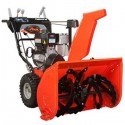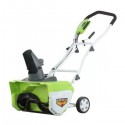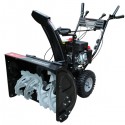Snow Blower Reviews
These are the 10 best snow blowers based on product quality, customer satisfaction, and price:
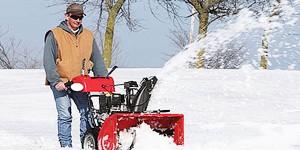 When winter starts gearing up and snow storms are looming over the horizon, the last thing you want is to be unprepared to clear heavy snow accumulations from your property.
When winter starts gearing up and snow storms are looming over the horizon, the last thing you want is to be unprepared to clear heavy snow accumulations from your property.
One of the most tedious parts of winter is trying to clear heavy snow fall from your driveway and sidewalks by hand. Not only is this job tiring and time consuming, it can also be dangerous: studies show that manually shoveling show has a direct link to higher incidences of heart attack, especially in at-risk populations.
Shoveling snow by hand makes your heart work a lot harder, and when that is combined with being exposed to temperatures that are below freezing, older persons are at much greater risk for suffering a heart attack. This is not to mention the fact that just about everyone will wind up with a sore back and aching shoulders after they have spent half an hour or more shoveling out their driveway.
Beyond that, shoveling snow by hand is inefficient: the rate at which even the fastest, most athletic person could clear a driveway by hand is still far longer than it would take anyone who was using even the most inefficient snow blower. A snow blower takes most of the work out of clearing a driveway, and on bigger jobs and in regions where a lot of heavy snow fall occurs on a regular basis, using a snow blower is virtually a must. These machines take the vast majority of the work out of clearing heavy snow fall from your driveway and sidewalks, and they can make your life much easier and you winter much more enjoyable.
But how do you know what kind of snow blower is right for your needs? There are a stunning variety of snow blowers available on the market today, and they fit into categories and sub-categories that can leave someone who has never shopped for a new snow blower reeling from all of the options. Snow blowers these days can be gas powered or electric. Gas powered snow blowers have a wide variety of engine designs and sizes, and electric snow blowers can be plug in or battery powered. Snow blowers can be single-stage or two-stage, in which either the auger does all of the work of throwing the snow, or the auger passes the snow up through an impeller fan, which pulls it up and throws it through the snow chute.
Snow blowers also come in a wide variety of sizes, from very small residential designs that are made to clear light snow fall from small areas all the way up to commercial grade models that are designed to clear the heaviest snow fall from big parking lots or extra-long driveways. Deciding which kind is right for your needs can be a real challenge. When you are shopping for a new snow blower, there are a few basic criteria to keep in mind that will make your job much easier. They include the size of the area to be cleared, the typical amount of snow fall your region gets, whether you need a single-stage or two-stage machine, whether you want a gas or electric snow blower, and how much you want to spend.
1. Snow Blower Selection Criterias
1a. Driveway Size
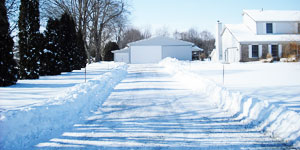 The size of the area you will need to be keeping clear of snow through the winter is the first major factor that will affect what kind of snow blower you will want to purchase. Bigger driveways, naturally, need bigger machines to keep them clear. Of course, it is not quite that simple, so there are a few other things to look at than just the gross area of the driveway you will need to keep clear.
The size of the area you will need to be keeping clear of snow through the winter is the first major factor that will affect what kind of snow blower you will want to purchase. Bigger driveways, naturally, need bigger machines to keep them clear. Of course, it is not quite that simple, so there are a few other things to look at than just the gross area of the driveway you will need to keep clear.
In order to clear a big space as efficiently as possible, you will want to make sure the clearance width of the snow blower is efficiently maximized. A snow blower with a bigger clearance width will be able to clear a big area of snow in fewer passes than one with a smaller clearance width. Fewer passes mean less time spent clearing snow, and less time spent clearing snow means more time indoors where it is warm and cozy. But maximizing the snow blower’s clearance width efficiently is not as simple as buying the biggest machine you can afford.
While it may be tempting to simply get the snow blower with the biggest clearance width, there are a few other things you have to take into consideration as well. For example, in addition to the size of the driveway, are there any walkways that will need to be cleared? If so, what are their widths? You do not want to get a machine that has a clearance width that is so big that you will not be able to fit it through the garden gate or efficiently clear narrower sidewalks. And if there are any tight corners that you will need to keep clear, a snow blower with a bigger clearance width will be less maneuverable than a smaller one.
In addition to maneuverability, you have to take storage space into consideration as well. Snow blowers with bigger clearance widths will have larger overall dimensions as well, which means it will require a lot more storage space in your garage or tool shed. If you do not have the room to spare, and your driveway is not massive, you may want to opt for a model with a smaller clearance width. Finally, machines with huge clearance widths are going to cost more than smaller ones, and use more fuel over the long term. Is the extra money worth the additional few inches?
1b. Snow Fall Depth
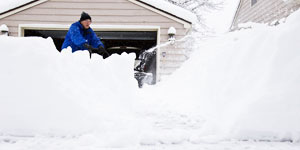 The next important thing to consider when you are shopping for a new snow blower is the amount of snow fall your region gets at any one time during the winter. For the most part, you probably have at least an anecdotal familiarity of the kind of snow storms your region experiences. States in the northern Great Plains and the Northeast tend to have the deepest snow fall from one storm to the next, and routinely experience blizzards that drop more than a foot of snow at one time. By comparison, areas like the Atlantic States and Pacific Northwest tend to experience much milder snow storms that tend to not drop more than six inches or so at a time.
The next important thing to consider when you are shopping for a new snow blower is the amount of snow fall your region gets at any one time during the winter. For the most part, you probably have at least an anecdotal familiarity of the kind of snow storms your region experiences. States in the northern Great Plains and the Northeast tend to have the deepest snow fall from one storm to the next, and routinely experience blizzards that drop more than a foot of snow at one time. By comparison, areas like the Atlantic States and Pacific Northwest tend to experience much milder snow storms that tend to not drop more than six inches or so at a time.
Whatever the region is where you live, and however familiar you feel you are with the typical amount of snow fall you receive, it is always a good idea to review snow fall levels for the past ten years or so to get a better idea of the average amount of snow that accumulates from one storm to the next in your area. By doing this, you can get a clear idea of what an average snow storm will drop at any one time, and base the decision for what kind of snow cut depth you will need on your snow blower.
The snow cut depth describes the height of the auger on the snow blower, and it indicates how deep snow can get before the snow blower is no longer going to be effective at clearing it. It goes without saying that snow blowers with higher snow cut depths will be able to clear heavier accumulations of snow. If you live in a region that routinely receives heavy snow storms, you will want a snow blower that is equipped to handle this kind of accumulation. But if you do not receive a lot of snow at one time, there can be drawbacks to getting a snow blower with a very high snow cut depth.
While it can be tempting to go for the snow blower that has the highest snow cut depth, not unlike clearance width sizes this can have disadvantageous. A snow blower with a high snow cut depth is going to be heavier, bulkier, and harder to maneuver than a smaller one. You may have trouble finding adequate storage space for it. And it is going to cost a lot more.
1c. Gas / Electric
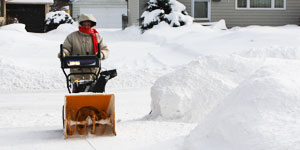 You can opt for a gas powered or electric snow blower, but the one you choose will ultimately depend on a number of considerations. Gas powered snow blowers have the advantages of being able to support larger clearance widths, higher snow cut depths, and can be single-stage or two-stage. Electric snow blowers are only available in single-stage, and while they are not as large or robust as some of the more powerful gas powered snow blowers, they can compete in terms of size and snow clearance capacity with smaller and single-stage gas powered snow blowers, and they offer a number of other advantages as well.
You can opt for a gas powered or electric snow blower, but the one you choose will ultimately depend on a number of considerations. Gas powered snow blowers have the advantages of being able to support larger clearance widths, higher snow cut depths, and can be single-stage or two-stage. Electric snow blowers are only available in single-stage, and while they are not as large or robust as some of the more powerful gas powered snow blowers, they can compete in terms of size and snow clearance capacity with smaller and single-stage gas powered snow blowers, and they offer a number of other advantages as well.
Unlike gas powered snow blowers, which are fairly noisy and produce a high level of carbon emissions, electric snow blowers run very quietly and produce zero emissions at the point of use. The Environmental Protection Agency estimates that the average gas powered snow blower produces as many carbon emissions as a car that has been driven for seventy miles. In addition, the EPA estimates that gas powered yard and garden machines are responsible for about 25% of carbon emissions produced by mobile sources. As you can see, switching to an electric snow blower can significantly reduce your household’s overall carbon footprint, and can help you go a long way toward doing your part for the environment.
At the same time, electric snow blowers have their limitations. While most electric snow blowers are sufficiently powerful and big enough to handle medium sized suburban driveways and sidewalks, they tend to top out at about eighteen inches of clearance width and generally do not have snow cut depths that are much higher than twelve inches. As a result, if you live in an area that does not experience particularly heavy snow storms, and you do not have a huge driveway, an electric snow blower could be right for you. But for a number of other situations, a gas powered snow blower is usually the best way to go.
Two-stage snow blowers are only available with gas powered engines, and there are a few situations in which they are the only kind that will get the job done. Two-stage snow blowers are best for very big jobs, because they can support extremely large clearance widths and very high snow cut depths. They are also better for clearing unpaved areas, because their auger does not make contact with the ground surface.
1d. Single-Stage / Two-Stage
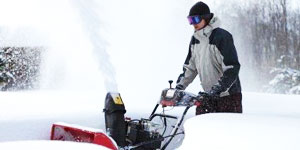 Within the category of gas powered snow blowers, there are two kinds of machines: single-stage and two-stage snow blowers. Each one is designed for a particular type of job. On single-stage snow blowers, the auger, or the component that scoops up snow, is the only piece involved in clearing snow and throwing it though the snow chute. On two-stage snow blowers, in addition to the auger there is a second piece, the impeller fan, which pulls snow up from the auger and pushes it through the snow chute. Each type of machine has its advantages and drawbacks.
Within the category of gas powered snow blowers, there are two kinds of machines: single-stage and two-stage snow blowers. Each one is designed for a particular type of job. On single-stage snow blowers, the auger, or the component that scoops up snow, is the only piece involved in clearing snow and throwing it though the snow chute. On two-stage snow blowers, in addition to the auger there is a second piece, the impeller fan, which pulls snow up from the auger and pushes it through the snow chute. Each type of machine has its advantages and drawbacks.
A single-stage snow blower is generally a smaller machine overall than a two-stage snow blower. This is because these machines typically do not have the kind of big, robust engines that can support augers with wider clearances or higher snow cut depths. Single-stage snow blowers are designed to be used on average and slightly above average suburban properties, and are perfect for clearing medium driveways and longer sidewalks.
On these machines, the auger makes contact with the surface of the ground. This is useful on paved areas, as they usually are able to leave a clean surface behind them. But they should not be used on unpaved surfaces, as there is a risk that the auger will scoop up gravel or other debris along with the snow. This can present a danger of damaging the snow blower itself, or worse, injuring the operator. Because the auger makes contact with the ground, it is important to ensure you are purchasing one that is made of durable enough materials to hold up to wear and tear.
A two-stage snow blower will be much larger than a single-stage snow blower, and as a result, these machines are better equipped to handle very large jobs. Two-stage snow blowers can support clearance widths up to about three feet wide, and have snow cut depths of well over two feet. As a result, these are the real work horses of the snow blower family, and are perfect for use in areas that regularly experience heavy snow fall all winter long. They are also equipped to deal with big jobs quickly and efficiently, making them a favorite of landscaping professionals and grounds crews. Because the augers on two-stage snow blowers do not make contact with the surface of the ground as they pass over it, they are also ideally designed to clear unpaved areas and gravel drives.
1e. Blower / Shovel
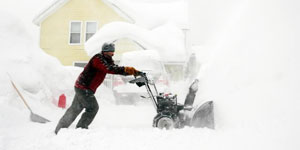 After reading the preceding sections, you may be thinking to yourself that while you certainly do not want to continue clearing snow the old fashioned way – by hand – you also think that a snow blower might be a bit much for your needs. If this is the case, you have another excellent option for clearing snow: the electric snow shovel. These handy little machines are designed for clearing light snow fall from very small areas, and they are able to take most of the work – the bending, lifting, and throwing snow – out of the job. With one of these machines, you can avoid all of the strain and stress of manually clearing snow without winding up with a machine that is too bulky to be efficient for your needs.
After reading the preceding sections, you may be thinking to yourself that while you certainly do not want to continue clearing snow the old fashioned way – by hand – you also think that a snow blower might be a bit much for your needs. If this is the case, you have another excellent option for clearing snow: the electric snow shovel. These handy little machines are designed for clearing light snow fall from very small areas, and they are able to take most of the work – the bending, lifting, and throwing snow – out of the job. With one of these machines, you can avoid all of the strain and stress of manually clearing snow without winding up with a machine that is too bulky to be efficient for your needs.
Electric snow shovels work by using a small plastic auger to scoop up snow and throw it forward in front of the machine as you direct it through the snow. They do not have snow chutes, and usually have snow clearance widths of less than fourteen inches, and snow cut heights of less than eight inches. This makes them too small to use efficiently on larger jobs or in areas that routinely experience heavy snow fall, but perfect for use on patios, decks, or porch stairs in regions that only receive lighter accumulations of snow.
One of the major advantages that electric snow shovels offer is that they have extremely compact dimensions overall. As a result, you can easily find enough storage space for them in a hall closet or even in your front foyer – where the machine will always be right at hand so you can start clearing snow as soon as you step out your front door. These machines are also lightweight; the heaviest of them still weigh less than twenty pounds. As a result they are perfect for senior citizens or persons who do not have the kind of strength necessary to use heavier machines.
Best of all, electric snow shovels are considerably less expensive than most snow blowers. As a result, you can get all of the benefits of a power snow clearing machine without having to spend the kind of money a snow blower costs. And because they generally use a lot less power than electric snow blowers do, you will be able to enjoy continued savings over the long term.
2. Snow Blower Reviews
There are a number of options for what kind of snow clearing machine you can buy. You can get an electric snow shovel for clearing the smallest areas. For larger areas, you will want a snow blower. Among these, you can buy an electric or gas snow blower, and a single-stage or two-stage machine.
2a. Electric Snow Shovel Reviews
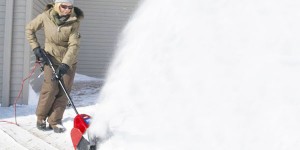 Electric snow shovels are designed to take the majority of the work out of clearing snow from small areas such as patios, decks, porch stairs and short sidewalks. They are able to take care of accumulations of about six inches or less, and have clearance widths that are less than fourteen inches. These machines are lightweight and easy to store and use, but they are also limited in terms of the size of the job they can handle as well as how much snow they can reliably handle. They are recommended for small jobs in regions that do not experience heavy snow fall.
Electric snow shovels are designed to take the majority of the work out of clearing snow from small areas such as patios, decks, porch stairs and short sidewalks. They are able to take care of accumulations of about six inches or less, and have clearance widths that are less than fourteen inches. These machines are lightweight and easy to store and use, but they are also limited in terms of the size of the job they can handle as well as how much snow they can reliably handle. They are recommended for small jobs in regions that do not experience heavy snow fall.
- Best Use: Patios, decks, and sidewalks with minimal snow accumulation.
- Pros: Lightweight, compact, and easy to store and use.
- Cons: Limited in clearance width and snow cut depth.
2b. Electric Snow Blower Reviews
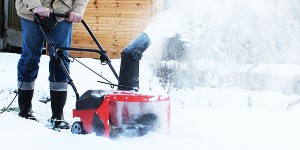 Electric snow blowers are designed to be an alternative to gas powered snow blowers, and are well equipped to deal with smaller and medium sized suburban driveways and sidewalks. Unlike gas powered snow blowers, they produce zero emissions at the point of use and are much quieter. They are also much easier to maintain and less expensive to operate and keep running. Electric snow blowers generally have smaller dimensions than gas powered snow blowers and are more lightweight, but still are able to support comparable clearance widths and snow cut depths. They are generally plug-in, but cordless machines are also available.
Electric snow blowers are designed to be an alternative to gas powered snow blowers, and are well equipped to deal with smaller and medium sized suburban driveways and sidewalks. Unlike gas powered snow blowers, they produce zero emissions at the point of use and are much quieter. They are also much easier to maintain and less expensive to operate and keep running. Electric snow blowers generally have smaller dimensions than gas powered snow blowers and are more lightweight, but still are able to support comparable clearance widths and snow cut depths. They are generally plug-in, but cordless machines are also available.
- Best Use: Small to medium sized driveways, sidewalks.
- Pros: Quiet, efficient, environmentally friendly, and inexpensive to run and maintain.
- Cons: Not as powerful as gas powered snow blowers.
2c. Gas Single-Stage Snow Blower Reviews
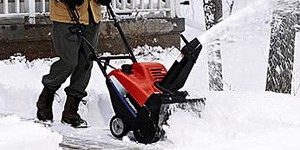 Gas single-stage snow blowers are designed for use on medium to large driveways, and have the kind of combustion engines that can generally support bigger clearance widths and higher snow cut depths than are available on most electric snow blowers. These reasons are why many consumers still prefer them to electric snow blowers, especially those who live in regions that experience heavier snow fall. On the other hand, they are quite noisy and produce a lot of emissions. These machines make contact with the surface of the ground, unlike two-stage snow blowers, so they are not recommended for unpaved surfaces.
Gas single-stage snow blowers are designed for use on medium to large driveways, and have the kind of combustion engines that can generally support bigger clearance widths and higher snow cut depths than are available on most electric snow blowers. These reasons are why many consumers still prefer them to electric snow blowers, especially those who live in regions that experience heavier snow fall. On the other hand, they are quite noisy and produce a lot of emissions. These machines make contact with the surface of the ground, unlike two-stage snow blowers, so they are not recommended for unpaved surfaces.
- Best Use: Medium to large driveways with paved surfaces.
- Pros: More powerful than electric snow blowers.
- Cons: Create emissions, noisy, less powerful than two-stage snow blowers.
2d. Gas Two-Stage Snow Blower Reviews
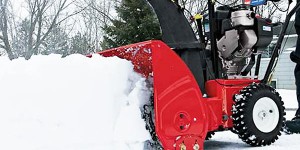 Gas Two-stage snow blowers are the biggest and most powerful walk behind snow blowers available today. They have the largest clearance widths, the highest snow cut depths, and the greatest per-minute snow clearance capacities of any snow blowers out there. They also have the largest overall dimensions and weigh the most, and are usually equipped with a drive system. Their auger does not make contact with the ground as it scoops up snow, so they are ideal for unpaved surfaces. The auger on two-stage snow blowers passes snow to an impeller fan, which then throws it through the snow chute.
Gas Two-stage snow blowers are the biggest and most powerful walk behind snow blowers available today. They have the largest clearance widths, the highest snow cut depths, and the greatest per-minute snow clearance capacities of any snow blowers out there. They also have the largest overall dimensions and weigh the most, and are usually equipped with a drive system. Their auger does not make contact with the ground as it scoops up snow, so they are ideal for unpaved surfaces. The auger on two-stage snow blowers passes snow to an impeller fan, which then throws it through the snow chute.
- Best Use: Unpaved surfaces and very large areas.
- Pros: Can handle the biggest jobs and deepest snow fall.
- Cons: Have very large footprints, are heavy, and use a lot of fuel.
At the end of the day, it will be up to you to determine what your snow clearance needs are and decide what kind of snow removal machine is best for you. Whether it is an electric snow shovel, electric snow blower, or gas powered single-stage or two-stage snow blower, I hope my snow blower reviews help you figure out exactly what kind of machine you want to purchase.
These are the 10 best snow blowers based on product quality, customer satisfaction, and price:

